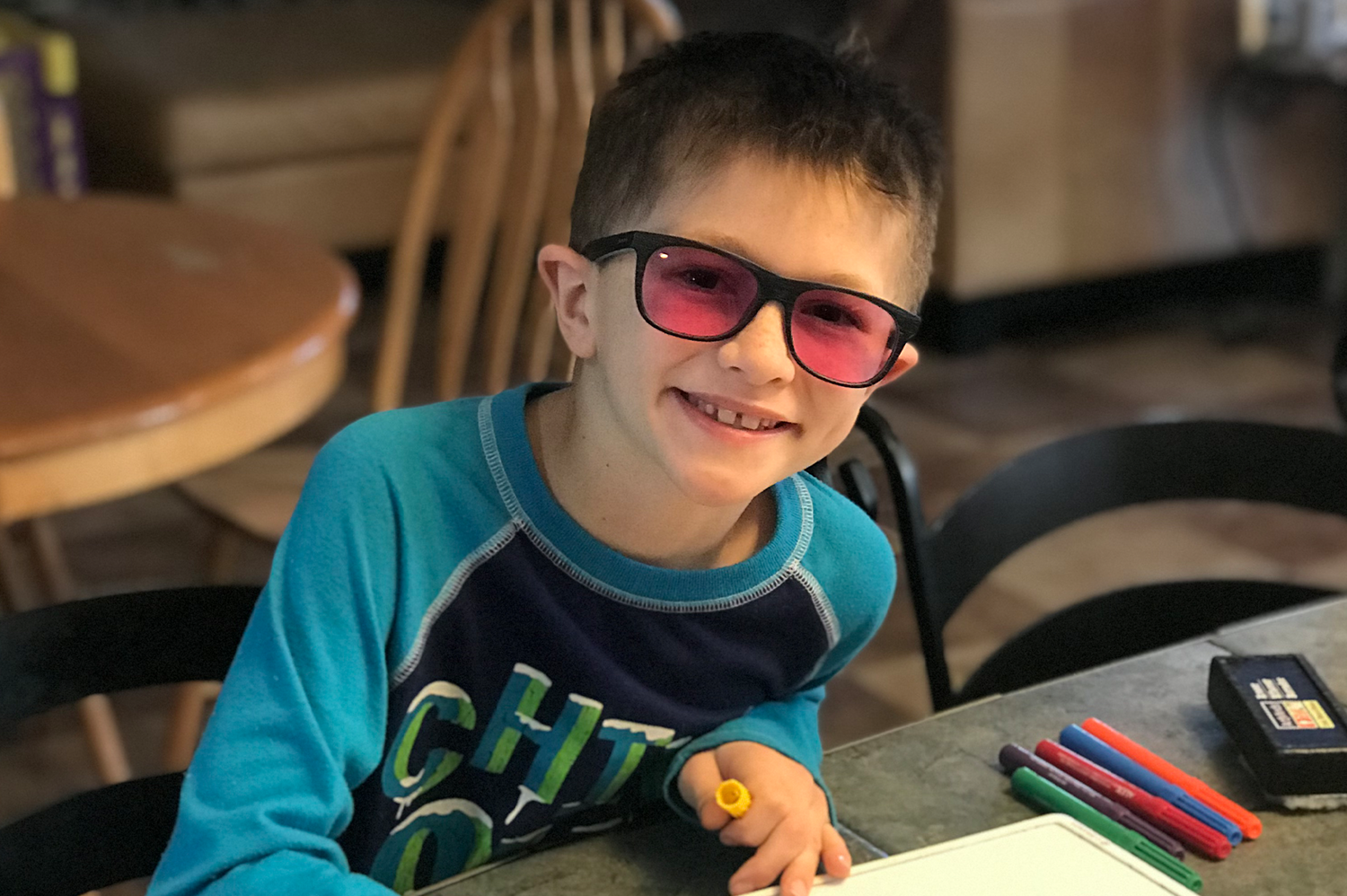We’re often asked when to get the first pair of EnChroma glasses for a child with color blindness. The answer can certainly vary and depends on you and your child. Bottom line-- we recommend EnChroma glasses for ages 5 and up.
Children develop their color vision by the age of 6 months. Before long, color naming becomes a fundamental part of their personal experience of color. For the color deficient child, the “normal” experiences of and names for colors do not match their own. These differences vary depending on the type and extent of color vision deficiency, but for many, confusions between certain colors such as blue and purple, yellow and green, and the inability to see the difference between pink and gray, are the most common confusions. Because 96% of the population is not color blind and have little understanding of its symptoms, the experience of a child with color blindness can be alienating and can have an effect during early education.
According to the Committee on Vision Assembly of Behavioral and Social Sciences National Research Council, because of the “use of color coding in school materials, it is of growing importance to identify congenital color defects in young children. Many observers with a congenital color defect retain memories of being treated as “stupid” or “troublemakers” because they had difficulties making color discriminations that were immediately evident to color-normal observers.¹

What Age Can My Child Be Tested for Color Blindness?
The ideal time to test children for color blindness is when they are around 5 or 6 years old, as they approach school age, according to the American Optometric Association. “Early detection of color deficiency is vital since many learning materials rely heavily on color perception or color coding. This is one reason the American Optometric Association recommends that all children have a comprehensive optometric examination before they begin school."²
More than 300 million people have color blindness, affecting as many as 8% of males and 0.5% of females.³ Common “red-green” type color blindness is inherited from a recessive gene carried by the mother, which means that a child may be color blind even if both parents have normal color vision. Therefore, it is important that all children are tested for color vision deficiencies at the earliest possible age. We here at EnChroma hope to bring as much color as we can to as many children as we can, which is why we recommend testing your child for color blindness around the age of 5 or 6. Learn more about color blindness.
How to Administer the EnChroma Color Blind Test for Your Child
The EnChroma Color Blind Test is a proprietary online self-administered test developed by EnChroma to help people get more information about their color vision. The test results indicate which type of color blindness was detected and how strong it might be: mild, moderate or strong. When testing children as young as 5, use the following steps for best results:
-
Select a time of day when your child is alert and able to pay attention to the test for up to 5 minutes without distractions.
-
Seat the child comfortably so they have a direct view of the computer screen (or tablet or phone). They should be looking straight at the screen and not viewing it from an angle. Off-axis viewing could affect the test results.
-
Ensure the screen appears to have a good brightness level and is not washed out by sunlight or other room lights. A darkened room is ideal. If you have a mobile device set the screen brightness manually to medium or high brightness.
-
If your child is not able to operate the mouse on their own, the adult should “drive” while the child’s task is to say what they see.
- For younger children who do not yet know their numbers, we recommend using the “symbol” testing mode, which presents one of three symbols: square, circle or triangle.
How EnChroma Glasses Help Kids: For Education and Self-Esteem
EnChroma was founded in 2010 with the mission to bring better color vision to people with color blindness. We have always believed that the best time to introduce an intervention for color blindness is with children, because they are going through a key phase of development where information and sensations are being integrated to build key life skills, children stand the most to gain.
Some have referred to EnChroma glasses as “correcting” or “curing” color blindness, however, these are not accurate descriptions of the technology. EnChroma glasses are an assistive device that aids the vision of a color blind person. When it comes to children, we have seen that the real value of the glasses is as a learning aid to help them better understand the world of color and how to talk about it.
Over the years we have heard many touching stories from parents who report that their children have found success using EnChroma glasses in the classroom and in their daily lives, whether it’s learning, making artwork, or playing. Some parents have even noticed a boost in confidence and ease given their child’s enhanced ability to interpret color coded information, even when not wearing the glasses. Then there’s the joy factor. Bright, fun colors delight kids of all ages so EnChroma glasses naturally enhance early childhood experience.
Learn more about children and color blindness in our blog, Color Blindness in the Classroom & Beyond.

How to Choose the Right EnChroma Glasses for your Child:
Once you have had your child take the test and identified that your child is color blind, many parents want to know what they can do about it.
EnChroma makes glasses for color blindness sized in frames for children in two age brackets: 5-10 and 10+. The lenses are the same technology found in the adult EnChroma glasses. These frames are specifically designed to fit smaller faces, and are constructed from durable materials that will hold up to the unpredictable occasions of any child’s daily life. EnChroma glasses for kids can be purchased directly from us online, and we back each purchase with our 60-day trial guarantee.
EnChroma offers indoor and outdoor lenses designed to work in different lighting conditions. Outdoor lenses will create the greatest color impact because of the nature of brighter light. Indoor glasses can be best for school and lower light settings. See the lens guide for more information about the types of lenses. A sizing guide for frames can also be found on each product page.
EnChroma Authorized Retailer Locations
For those parents who want professional guidance, EnChroma is proud to partner with hundreds of outstanding optometrists around the world who are part of our EnChroma Authorized Retailer network. These eye care professionals are trained to explain the EnChroma product line and can help you fit the best lens and frame for your child. All of our EnChroma lenses can also be customized with a prescription.
If you have any questions about ordering please Contact Us for assistance!
Sources:
¹ ”Procedures for Testing Color Vision, Report of Working Group 41,” Committee on Vision Assembly of Behavioral and Social Sciences National Research Council, NATIONAL ACADEMY PRESS, 1981
² AOA (n.d.). Color Vision Deficiency. Retrieved from https://www.aoa.org/patients-and-public/eye-and-vision-problems/glossary-of-eye-and-vision-conditions/color-deficiency
³ Simunovic, M. P. (2010). Colour vision deficiency. Eye, 24(5), 747-755. doi:10.1038/eye.2009.251
Share your story and join the #EnChroma community!




